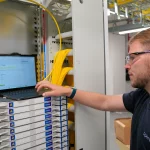Ofcom Toughens Personal UK Broadband ISP Speed Estimates

Ofcom has today announced that they intend to toughen their existing Broadband Speed Code of Practice, which among other things requires UK ISPs to supply consumers with a personal estimate of their broadband line speed before buying. Under the new change this estimate will become more accurate, but there’s a catch.
At present such line performance estimates are based on data from a group of customers whose properties have similar characteristics (e.g. distance from the exchange or street cabinet), which is of more relevance to those with hybrid fibre or pure copper broadband lines (e.g. ADSL, FTTC / VDSL2, G.fast) where signals tend to degrade over distance (i.e. slower speeds on longer lines).
Unfortunately the current approach may not entirely reflect the capabilities of some lines, which can lead to misleading results. However, under Ofcom’s new change, ISPs will in future be required to issue a speed estimate that is instead “based on the capability of the line going into their individual house or office.”
Advertisement
The speed estimate is very important, not least because Ofcom’s rules give customers the right to exit their contracts, without penalty, if their download speed falls below the minimum level. As such the more accurate this figure is, the better the situation for both consumers and providers alike.
Where infrastructure providers or wholesalers make the live sync speed of an individual line available to internet service providers (ISPs), ISPs must use this as the basis for speed estimates if they use the same infrastructure and access technology to provide their service
This means some customers will receive a more personalised speed estimate, because it would be based on the observed access speed of their specific line, rather than estimated.
We took a quick look at the technical detail of this announcement and noticed a couple of caveats, which weren’t stated in the introduction. Firstly, the change will not apply to pure copper ADSL lines because Openreach (BT) claims to “only” hold live sync data for hybrid fibre VDSL2 (FTTC) lines. Likewise it seems as if hybrid fibre G.fast lines escape due to some technical differences and the fact that there isn’t enough data yet to consider whether it should apply to them (this is under review for the future).
Implementing these changes will of course require ISPs to upgrade their systems and as a result members of Ofcom’s code have agreed to do this by 15th November 2020. At present the regulator’s 2019 speed code is only supported by the following providers: BT, EE, PlusNet, Sky Broadband, TalkTalk and Virgin Media (Daisy and XLN can be added when looking at business packages).
Mark is a professional technology writer, IT consultant and computer engineer from Dorset (England), he also founded ISPreview in 1999 and enjoys analysing the latest telecoms and broadband developments. Find me on X (Twitter), Mastodon, Facebook, BlueSky, Threads.net and Linkedin.
« Virgin Media Covers 4,000 Rural Test and Dun Valley Premises






















































Good.
I once lived in an VM over-utilised area. We had the connection before it was over capacity, then they went on a big local ad drive and signed up loads of customers. The result was a 200Mb connection becoming unusable (sub 1Mb) at peak times.
I went to the local VM shop and pretended to be a new customer and asking what speeds I could get at my address. The man in the shop literally pointed to the wall with Usain Bolt and ‘350Mb’ on it and said I would get fantastic speeds.
When I pointed out that, in fact, at my address the speeds were abysmal, he got incredibly rude incredibly quickly (more quickly than my internet speed, I must say) and pointed out that the terms say that speeds vary. I guess he was just annoyed I wasn’t actually a new customer.
The last straw came when I saw Virgin’s vans cabling up my opposite neighbour. I printed out my broadband graphs and a layman’s explainer of what they meant and popped it through their letterbox.
Before you ask – yes it was acknowledged as over-utilised by VM executive relations. What infuriates me so much about VM’s over-utilisation procedures is that they seem in no rush to improve capacity and they defer everything to the mythical tech team whom you as a customer are not allowed any contact with or even any updates from.
Anyway rant over, this is welcome news indeed.
This doesn’t impact VM.
CarlT, why not? This is hugely disappointing.
https://www.ofcom.org.uk/about-ofcom/latest/features-and-news/clear-information-before-you-buy-broadband
‘Currently, this speed information is based on data from a group of customers whose properties have similar characteristics – for example, distance from the exchange or street cabinet, which can affect speeds on copper broadband lines. In future, many customers will get a speed estimate based on the capability of the line going into their individual house or office.’
Every VM line syncs at full rate even if, due to capacity reasons, it cannot achieve that speed at peak times. Peak times the best VM can do is use their Samknows monitoring.
Short of monitoring every single VM customer with an automated Samknows Truespeed test, which would be a complex and difficult exercise, I’m not sure what VM could do.
Same goes for FTTP. This is for sync speeds more than throughput unfortunately.
Yeah Openreach won’t hold the ADSL sync speeds as it’s not their equipment terminating the ADSL lines.
It’s not for FTTC either though.
Yes it is. Openreach own the DSLAMs in the cabinets. That’s all they need to know, the performance between cabinet and home.
And except for unbundled lines, they own the kit in the exchange too.
They dont own the CPE in either case, so it’s a moot point regardless.
No they don’t.
BT Wholesale own the ADSL DSLAM’s.
Not if the line has been unbundled John.
Did you read the comment before mine?
It was just said that OpenReach owned the DSLAM’s that WERE NOT unbundled.
I made the point it was BT Wholesale (not OpenReach) who owned the DSLAM’s and MSAN’s in exchanges.
I never said anything about them owning the unbundled equipment.
Particularly given the point I was responding to I didn’t think that part needed adding.
Context.
I’m sure Ofcom will love the PR of the headline but this is at best small beer.
So if you don’t get the estimated speed (sync) you can cancel your contract.
Then what ?
Go to another provider utilising the same Openreach line and have exactly the same issue.
This doe nothing for the majority of customers you may have a choice of ISPs but only one infrastructure provider.
This is nothing to do with the article.
And yes, you move to another provider, one that will hopefully push Openreach harder as they offer better customer service.
If a line is genuinely underperforming it’s on the service provider to pursue Openreach for a fix.
Virgin are not excluded from the Minimum Guaranteed Download Speed obligation its just that its not to a specific line. They can be more confident of their HFC performance and therefore it is just based on a 50% of their specified service at the time of ordering.
https://www.virginmedia.com/shop/the-legal-stuff/virgin-media-speed-policy
So the 100M product has a download speed of 108Mbps and a minimum guaranteed download speed of 54Mbps.
Other speeds shown at https://www.virginmedia.com/shop/broadband/speeds
The issue here is that whether it is VM or OR the Ofcom rules only allow an under performance to enable you to leave your contract and switch provider but this is not much use when the underlying network provider is the only one that can support the speed you need. What should happen instead is there should be an obligation through the ISP to the network provider to investigate why technically the performance of the technology has reduced. I appreciate the complexity but if an FTTC or VM line is under say 80% of the minimum contracted surely it indicates an engineering issue and it should be resolved by the network provider.
Those speeds are directly to the Hub, so if you do a speedtest and get shit speeds but then Virgin do the line test and it’s fine/reporting proper speeds – you get nothing, no right to cancel.
Yes VM test to the hub however their help guidance recommends speedtest.net . Therefore if the speed test is from a wired device, using speedtest.net and is appreciably lower than the min they should send an engineer. That is why Ofcom should enforce the network provider to ensure the technology performs to a standard and why I say we should not have VM or FTTC “superfast” lines running less than 20Mbps.
In the case of OR I can’t see why they can identify slow FTTC proactively.
This is nothing to do with the original article which noted that VM specifically signed up to the guarantee.
To automatically send an engineer to a property served by VM if a test to the hub reported a low speed would be absurd. Much as testing every hub on the network without prompting would be absurd.
You expect Openreach to offer pro-active support and monitoring on a service they charge a fiver a month for and do not have direct end user involvement with?
What is the purpose of getting a speed estimate at contract if over the period of that contract the service from the network provider can deteriorate well below it and no thing is done. I appreciate often the issue may be beyond the hub but where it can be reasonably proved (wired device by a customer or professional) that the end to end speed of the ISP product has fallen below then yes I think action should be taken.
The reference regarding OR being proactive was meant to relate to issues affecting wider than a single line. Individual ones via ISP.
Ofcom/Government appear to be proud to announce how many have access to Superfast based on premises passed but that is total lie if a percentage who take it up are not actually getting Superfast.
To be totally fair to OR they do carry out proactive repairs often without the end user knowing anything. Based on DSLAM line monitoring.
ADSL is sunset technology making CP’s aggregate data would be a waste of time. Some of the older kit also makes it quite hard to bulk collect the data.
I would rather everyone focused on wholesaling the increasing amounts of FTTP, Gfast, FTTC and maybe VM really well rather than waste time looking in the rear view mirror of technology.
Openreach do resolve wider failures. They monitor every DSLAM.
What they don’t do is babysit individual customer lines which, given the article at hand, seems to be what you’re suggesting.
Openreach’s customers are service providers, not end users. Service providers can implement their own monitoring and some do, but for latency, jitter and packet loss more than bandwidth.
I appreciate most issues are likely to be in the premises but the number of people complaining that their FTTC is slower than Superfast (24Mbps) or complaining about VM (where I would have assumed there would not be a problem) appear are high.
The Ofcom process is simply the right to cancel mid contract if the speed promised on order isn’t delivered. It does not resolve any issue on the line. i.e a FTTC Superfast product may be sold as 21Mb – 36Mb. This may be accepted by the user but over time the line then only performs at say 20Mbps. This is can no longer be regarded as Superfast either by Product or Ofcom’s % statistics for Superfast coverage. The user could change ISP but it unlikely any underlying issue will be resolved.
@CarlT
“Openreach do resolve wider failures. They monitor every DSLAM.
What they don’t do is babysit individual customer lines which, given the article at hand, seems to be what you’re suggesting.”
You expressed that much more clearly than I did and that was what I meant. Line card failure, in the DSLAM, etc is often picked up before it is reported.
At first BTw estimated my line for G.fast 114/9 but once it went live they are wrong! It was actually 259/39. More fool BTw checker unreliable one!
The same with VDSL estimated 66/19 but actually got 80/20 on FTTC
Don’t forget BTw checker isn’t including DLM banded on the line either!
That’s kinda the whole point of this – show the last sync achieved.
Those GFast line stats don’t make sense. The upstream tones are interleaved at the lower frequencies so GFAST gracefully deteriorates with an increasingly high upstream ratio. 110 down I would expect about 25-30 up.
Likewise 259 down would give about 43-45 up.
Sometimes Virgin Media Superhub 4 and TP Link fast internet broadband wi-fi home network when your netegar switch green lights running up medon live city of town your Virgin Media somewheres.
You need to reset the spambot.